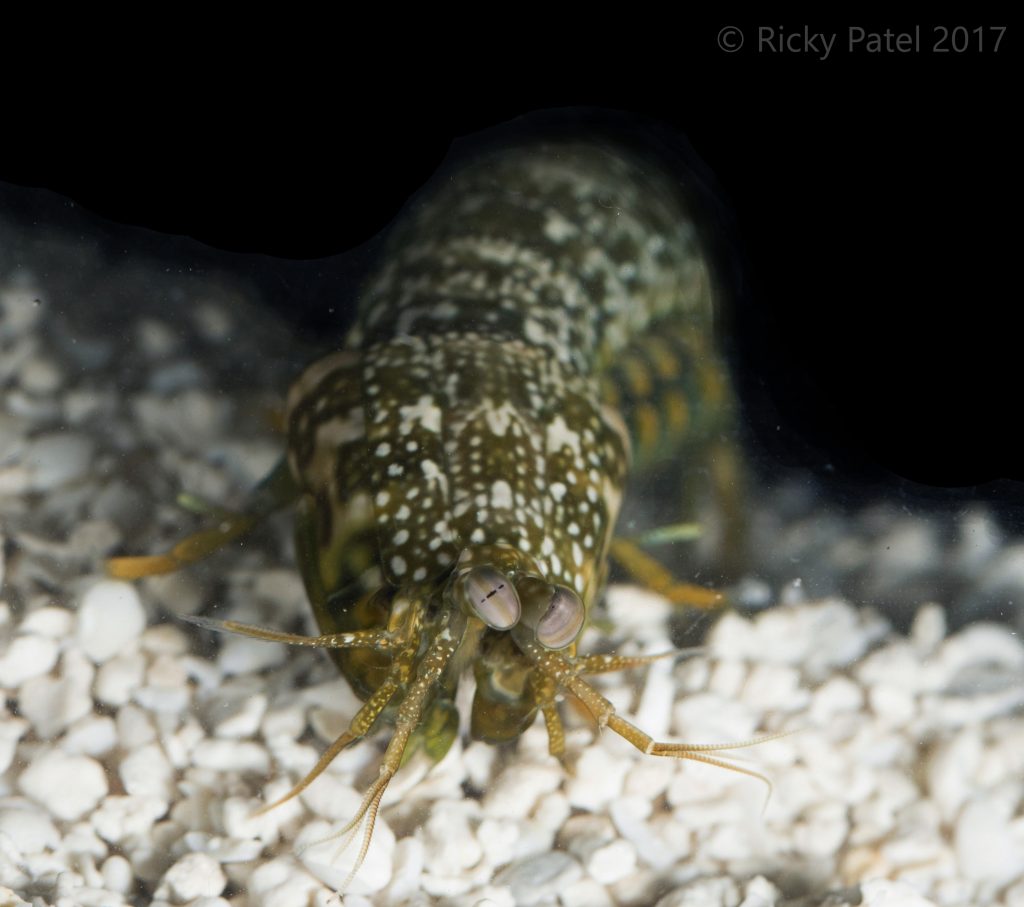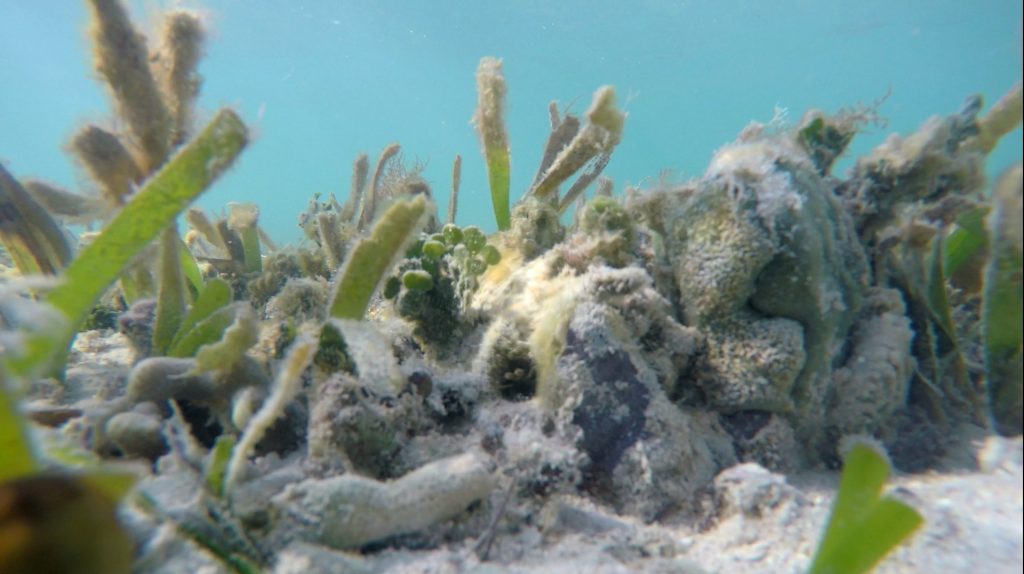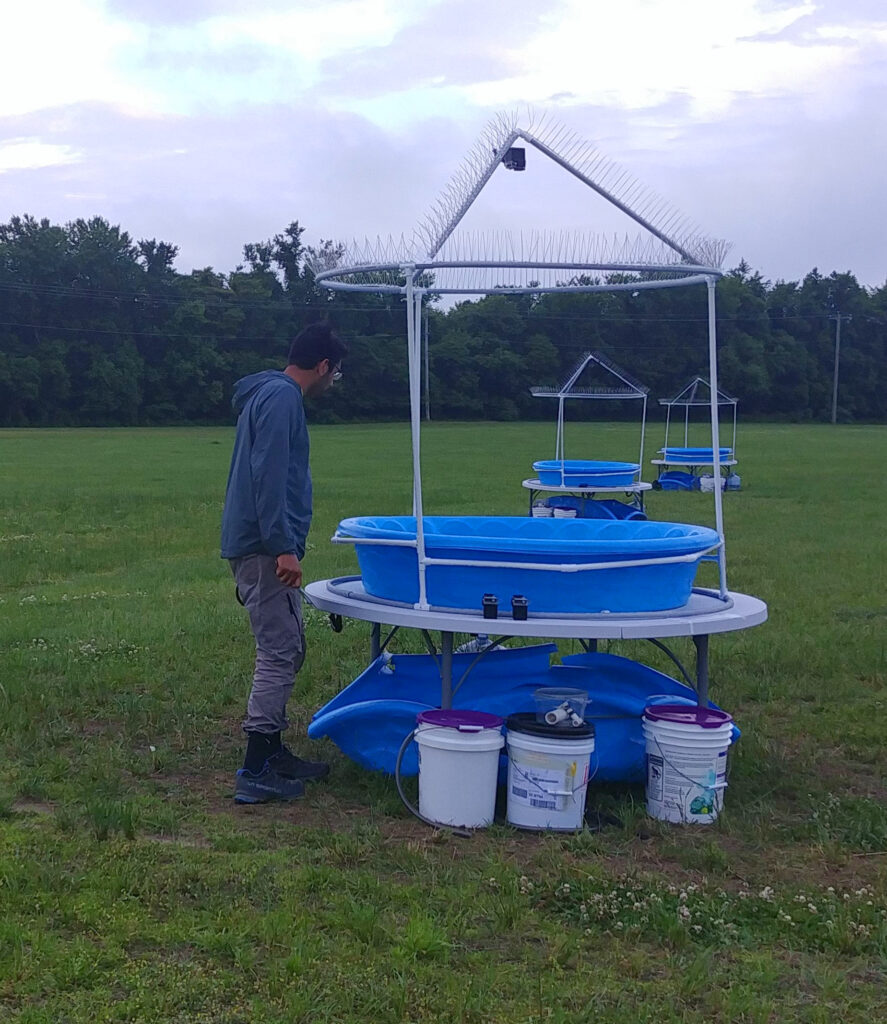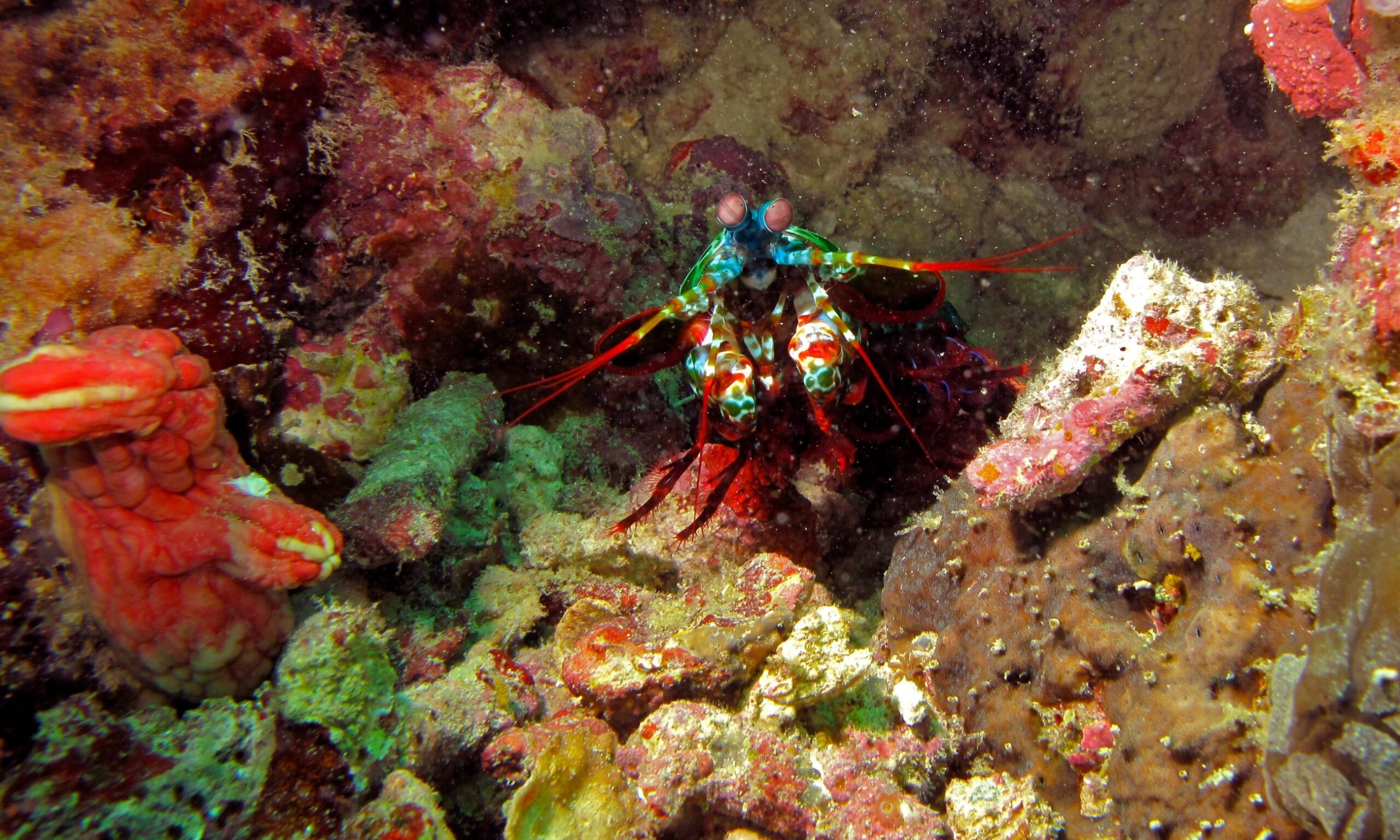Mantis shrimps have earned fame for their powerful punching limbs, incredibly unusual eyes, and vivid exoskeletons. And, it turns out, they’re also really good at finding their way home. Through a series of painstaking experiments with these often-uncooperative creatures, Rickesh Patel has produced new findings on mantis shrimp navigation, published today in Current Biology.
Patel, a Ph.D. candidate in biological sciences at UMBC, found that the species of mantis shrimp he investigated relies on the sun, patterns in polarized light, and internal cues—in that order—to navigate directly back to their non-descript burrows. These straight-line returns often follow forays that meander and zig zag as the shrimp looks for a meal or a mate. The ability to get home quickly comes in handy when seeking shelter in the presence of a predator, or a perceived one, as Patel noted on his first research fieldwork expedition.
After his first year at UMBC, Patel traveled with Tom Cronin’s lab to Lizard Island in the Great Barrier Reef to collect mantis shrimps for study. “As soon as they notice you, they’ll turn around and zip straight to some sort of shelter,” Patel says. Like a true scientist, “That got me wondering how they go about finding their way home.”

A crucial starting point
Scientists have written a great deal on navigation in other species—primarily bees, ants, and mice—but Patel’s is the first work on navigation in mantis shrimp.
First, Patel had to find a behavior he could work with to test ideas about how mantis shrimp navigate. So he created a small arena with an artificial shrimp burrow buried in sand. He placed the shrimp in the arena, and to his delight, the mantis shrimp was happy to occupy the small section of PVC pipe. Then he placed a piece of food at a distance from the burrow. He watched as the shrimp left its burrow, meandered until it found the food, and then returned to its burrow in a fairly straight line.
From those initial observations, Patel hypothesized that mantis shrimp use a process called path integration to find their way home. In other words, they are somehow able to track both their distance and direction from their burrow.
“That was probably the most exciting part of the experiments for me, because I knew I had a really robust behavior that I could work with,” Patel says. “Everything I did really extended from that initial point.”

Sunshine surprise
After that first discovery, the challenging work began, to figure out what cues the animals were using to determine the path home.
Patel built eight much larger arenas, each about 1.5 meters in diameter, to run his experiments. The first question he asked was whether the shrimp were using internal or external cues to go home.
To test that, Patel created a setup that rotated the animal 180 degrees as it retrieved the food. If the shrimp was using external cues to remember its distance and direction from home, it would still head in the right direction. If it was using internal cues, based on the orientation of its own body, it would head in the opposite direction. In the first round of trials, the animals consistently headed in the exact opposite direction.
“That was really cool, but it didn’t make a lot of sense,” Patel says, “because an internal compass is going to be a lot less accurate than something that is tied to the environment.” Then it hit him: “We just happened to have a really overcast week when I did these experiments, so I waited until we had a clear day, and then every time, they went right back home.”

Putting together the puzzle
Patel realized that his experiment perfectly demonstrated the hierarchy of cues used by the animals. They used external cues first, but when those weren’t available, they used internal cues.
That was the beginning of a long series of creative experiments that further teased out how these animals navigate. When Patel used a mirror to trick the animals into thinking the sun was coming from the opposite direction, they went the wrong way. This indicated they use the sun as a primary cue. When it was cloudy but not totally dark, they used polarization patterns in light, which are still detectable when it’s overcast. And when the sky was completely covered, they reverted to their internal navigation system.
A varied skill set
For Patel, creating the experimental arenas—essentially, the shrimp obstacle course—was almost as fun as getting the results. “That’s something I really enjoy—building things, creating things,” he shares. Patel studied art and biology as an undergraduate at California State University, Long Beach. “I think those skills lent me a hand in designing my experiments.”
Other skills Patel needed were patience and perseverance. “The animals will only behave maybe once a day, so if you scare the animal, you’ve lost that day,” he says.
For example, one of the experiments involved putting the animals on a track that pulled them to a new position, and seeing where they headed from there. “If the track is too jerky or goes too fast, they get scared and just don’t behave,” Patel says. “So I had to design the experiment so that it was so gentle they didn’t realize they were being moved.”
New questions
All of Patel’s patience has paid off with new findings that open up an array of future questions to answer. While path integration is well-documented in other species, mantis shrimp are the first to demonstrate the technique underwater. Looking up at the sky through water is a very different view than doing so through air, so Patel is curious how the animals’ process is different from other species.
Patel is also ultimately interested in the neural basis of navigation behavior, but “before you can investigate what’s happening in the brain, you have to understand what the animal’s doing,” he says. “So that’s why I really focused on the behavior work, to figure out what the animal is doing and what kind of stimuli are appropriate to show the animal that we can use to investigate its neurology.”
So far, other work has demonstrated that a brain region called the central complex has uncanny similarities between insects and mantis shrimps. This is especially interesting considering how far apart bees and shrimp are on the tree of life. The central complex is known to contribute to navigation in bees, so Patel is intrigued to learn more about its function in mantis shrimp. Alice Chou, another graduate student in the Cronin lab, is also investigating the brain structures of mantis shrimp.

UMBC to Europe
Other scientists in the U. S. and around the world are also interested in this work. Patel’s research, like other work in his mentor’s lab, is supported by the Air Force. They would like to know more about how animals use polarized light for navigation, on land and underwater, in hopes of imitating it in human-made systems.
Patel will have the chance to work on some of these questions as he continues his research career at Lund University in Sweden as a postdoctoral fellow, starting this summer. Right now, he’s thankful for the experience he’s had at UMBC, from that first summer through his dissertation research.
Patel says he benefited from being the mentee of Tom Cronin, professor of biological sciences and a pre-eminent scholar of mantis shrimp vision. “Tom has been great in that he’s given me complete freedom to approach any question I want to, while also being happy to offer advice when asked,” Patel says. “That combination has helped me grow into my own as a researcher.”
With this initial paper and more on the way, Patel has made the most of that freedom. His next chapter is sure to be one of further discovery.
Banner image: A peacock mantis shrimp. Photo by Bernard Dupont, shared under CC BY-SA 2.0
Tags: Biology, CNMS, GradResearch, Research

